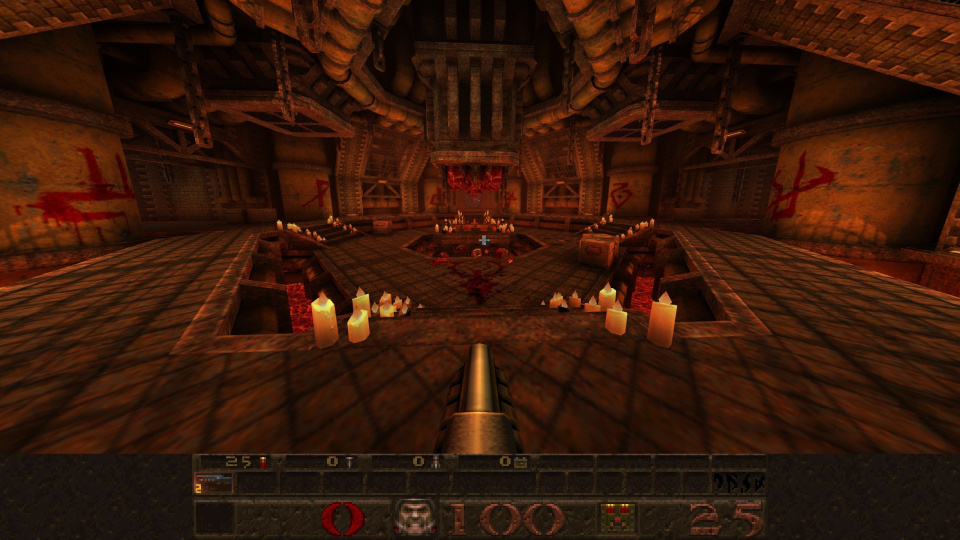Teasers
The Quake series from id Software has a long, storied history. For example, did you know that Quake was supposed to be a fantasy RPG? Or Quake 2 wasn't planned as a successor?
The first Quake from id Software was a technological milestone because it was one of the first games to use real 3D graphics. This was purely calculated by the CPU, because graphics accelerators were still in their infancy in 1997 (Voodoo was introduced in 1996). Quake, on the other hand, was playful and conservative; it did not stand out significantly from its internal quasi-predecessor Doom away. It was still necessary to find the end of each level, look for keys for doors and not die from the numerous enemies. In addition to the graphics, the big innovation was the level design – instead of Doom's strictly two-dimensional layout (higher rooms couldn't be on top of other rooms), the new labyrinths were now truly three-dimensional and complex.
Advertisement
Quake was intended to be a first-person fantasy RPG
That's why everyone worked on what they liked, which led to very different settings for the four episodes: the first comes mainly from Tim Willits and has slight SF leanings, the third from American McGee has a dark medieval setting and the fourth from Sandy Petersen clear Lovecraft influences. The second episode, for which John Romero was responsible, takes place in his favorite medieval fantasy world. To somehow bring the whole thing together, there was an alibi story about dimensional portals – but the clear line that Romero was supposed to ensure as design director did not exist.
When the engine was essentially ready, the id higher-ups decided, against Romero's wishes, to turn the mess into “just” a shooter in the style of Doom. This didn't bother the fans, Quake became a hit and to this day has a small but very loyal following, most of whom play the cards that the game was delivered with in multiplayer. Romero left id shortly after the game was released Ion Storm to found a company in which the game design and not the technology should be decisive for the games – with the motto “Design is law“.
 |
| The new episode in the new edition of Quake shows significantly more complex geometry than in the original. |
Linear SF story: Quake 2
On paper, the game was divided into episodes like its predecessor, but without freedom of choice – all of them had to be played in a fixed order. The game mechanics were largely the same with the classic shooter triumvirate of finding an exit, looking for keys and killing opponents. What was new was a simple item system, but it had its problems: if you reserved the quad damage bonus for the boss fight, for example, it was completely trivialized. The add-ons did a better job of this – and with one or two tricks they even made the use of the power-ups dangerous.
Quake 2 was initially not planned as a successor, but was supposed to appear under a new brand. But after the developers couldn't find a suitable one that was still available, it was quickly decided as Quake 2 brought on the market. The trade press and gamers were enthusiastic, but part of the community was upset that the title didn't have a multiplayer mode. In the first part it was such an important feature that later on QuakeWorld a client specialized in this appeared. The multiplayer part was added for Quake 2; It is still played today by a small circle. The game is also known as the hotbed of the three-wave mod, which established “Capture the Flag” as a game mode. McGee was fired from id Software shortly after the game's release, a fate that would befall other developers. Today he is mainly for crazy action adventures American McGee's Alice known.
Advertisement
Everything on Multiplayer: Quake 3 Arena
Quake 3 Arena took a completely different direction: as a pure multiplayer shooter, it took into account the increasing spread of Internet connections. Originally, it wasn't even supposed to include computer-controlled opponents (called bots in technical jargon); they, like the rudimentary single-player mode, were only added late in development. But the focus was entirely on the classic deathmatch. Curiously, the biggest competitor Epic Games had the same idea at the same time, which was… Unreal Tournament manifested. Both titles were released just a few weeks after each other and will celebrate their 25th anniversary at the end of this year.
The engine, later called id Tech 3, was to become the basis for many action games and especially first-person shooters in the early 2000s. Among other things, the engine of Call of Duty trace their roots back to this: the first part was created with it, and since then the engine has been further developed independently. However, there is likely to be very little code in current titles that can be traced back to John Carmack.
 |
| The new edition of the third part is still very popular today. |